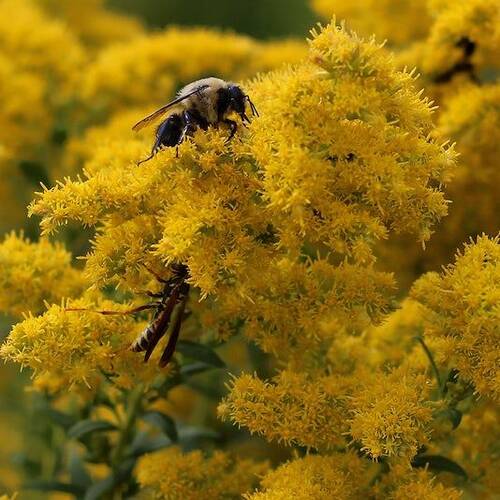Goldenrod, the Solidago species, the Hay Fever myth, and More
24/08/2022 03:39:22 PM
| Author | |
| Date Added | |
| Automatically create summary | |
| Summary |
As summer wildflowers fade away, the bright yellow flowers of goldenrod are coming into bloom and are supporting many pollinators, including the migrating monarch butterflies. The goldenrod will be soon joined by the purple New England asters. Unfortunately, goldenrod's pollen has been unfairly blamed for hay fever.
There are two types of pollen. The pollen causing hay fever, is light and fine, easily sent aloft by a slight breeze. Goldenrod's is the second type, heavy and sticky it adheres to insect pollinators. It is disseminated as the insects move from plant to plant collecting and feeding on nectar and pollen. Their flowers, colourful and showy, are alluring to insects.
 The real hay fever culprit is the "sneaky" ragweed with its inconspicuous green flowers that bloom at the same time and emit copious amounts of pollen.
The real hay fever culprit is the "sneaky" ragweed with its inconspicuous green flowers that bloom at the same time and emit copious amounts of pollen.
Like other plants, Goldenrod has co-evolved with the pollinators and other insects that depend on it. Non-native plants can have defence mechanisms that the native insects can't overcome. The Goldenrods are considered a key stone plant species, supporting much wildlife.
Some pollinators are generalists and will collect nectar and pollen from any bloom they can access, and many are specialists, requiring a specific native plant. Plants, might feed both kinds, and others only one insect.
Goldenrod feeds both the generalist and the "picky" specialist butterflies and moths, but also their caterpillars which feed on its leaves. In turn, the caterpillars with their soft, digestible bodies, provide a critical food source for nestlings. Goldenrod also hosts specialist bees that depend on its pollen to feed its young.
The plant continues to support wildlife during the fall and winter. Birds like downy wood peckers, chickadees, juncos and sparrows feed on their seeds, and many native bees overwinter in its hollow stems.
And those unsightly the Canada thistle? Despite its name, it's an invasive alien that attracts bumblebees to its nectar and goldfinches for its seeds. For goldfinches, a few favourites seeds include asters, coneflowers, sunflowers, and, "of course, thistles." There are native thistles, but that's for another post.
Stiff Goldenrod, Solidago rigida, is an attractive plant that you can consider adding to your garden. Alternatively, if goldenrod comes to your garden unbidden, allow a few to flourish and feed the many insects and birds that it attracts.
A bit of trivia
According to the University of Florida blog post on Goldenrod and the Hay Fever myth,
"Thomas Edison was one of the key scientists who developed a process to extract usable latex from readily available materials in the western hemisphere." He also developed a 12" tall goldenrod as a potential latex source when the rubber plant wasn't available during World War 1. The goldenrod's leaves were used for the latex extract.
References and extra reading
https://blog.nwf.org/2014/09/the-goldenrod-allergy-myth/ More about Goldenrod plants
https://capeconservationcorps.org/spotlight-on-native-host-plants-two-powerhouse-perennials/ Goldenrods and asters.
https://hgic.clemson.edu/insects-feed-baby-birds/ The importance of caterpillars to birds
https://www.childhoodbynature.com/why-your-yard-needs-more-caterpillars/ More of the science of native plants and caterpillar importance
https://www.birdsandblooms.com/birding/attract-goldfinches-backyard/ Attracting goldfinches to your backyard
Submitted by Shomrei Adamah
Thu, 18 April 2024
10 Nisan 5784
Upcoming Programs & Events
Apr 18 Ma Nishma? What's Happening in Israel? Thursday, Apr 18 7:00pm |
Apr 23 Passover Services Tuesday, Apr 23 9:00am |
Apr 23 Second Night Passover Seder Tuesday, Apr 23 6:30pm |
Apr 27 Join us to say Todah Raba and L’Hitraot to Yaron! Shabbat, Apr 27 10:00am |
Apr 29 Passover Services Monday, Apr 29 9:00am |
This week's Torah portion is Parashat M'tzora
| Shabbat, Apr 20 |
Candle Lighting
| Friday, Apr 19, 7:53pm |
Havdalah
| Motzei Shabbat, Apr 20, 8:58pm |
Erev Passover
| Monday, Apr 22 |
Subscribe to our Friends of Darchei Noam Mailing List


